7.2.4 practice modeling geometric sequences
Ball Bounce
You have chosen one ball; now you wil...

Mathematics, 02.02.2021 18:00 alexusray
7.2.4 practice modeling geometric sequences
Ball Bounce
You have chosen one ball; now you will predict how high it bounces on the 10th bounce.
In this assignment, you may work alone, with a partner, or in a small group. Discuss the results of your work and/or any lingering questions with your teacher.
1. Circle the ball you chose. (1 point)
Basketball Tennis ball Table-tennis ball
Writing an Equation
2. Assume that the ball rebounds the same percentage on each bounce. Using the initial drop height and the height after the first bounce, find the common ratio, r.
Note: Round r to three decimal places. Use this formula:
(3 points: 2 points for showing your work, 1 point for the answer)
r = _
3. State the general version of the recursive formula. (1 point)
4. Find the recursive formula for the height of your ball. Remember that the 1st term, a1, is the height of the ball on the first bounce.(2 points)
5. Fill out the following table for your ball's height after the first 3 bounces. Note: Let n = bounce number. The height on the 1st bounce, n = 1, is given. (2 points:)
Bounce n Height
First bounce 1 Basketball: 54 inches
Tennis ball: 58 inches
Table-tennis ball: 26 cm
Second bounce 2
Third bounce 3
6. Write the explicit formula for the geometric sequence of the height of the ball on the nth bounce. Use the formula an = a1 • rn – 1. Remember that the 1st term, a1, is the height of the ball on the first bounce. (2 points)
Solving the Problem
7. Using the explicit formula, find the height of the ball on the 10th bounce. (4 points: 2 points for showing your work, 2 points for the answer)
Taking Time to Reflect
8. What are some factors that could affect the ball's bounce? Why might a ball bounce higher or lower than the regulated height? (1 point)
9. For the sport you chose, why would it matter if a player used a ball that bounced higher than the regulation? (1 point)
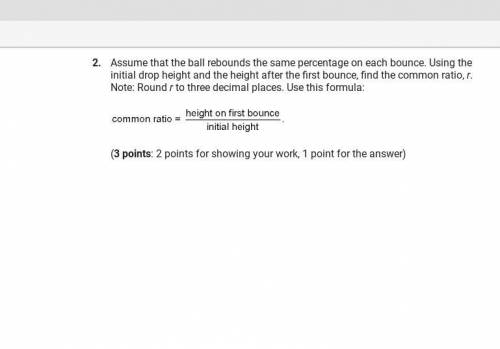
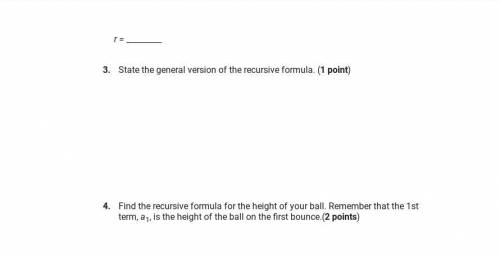
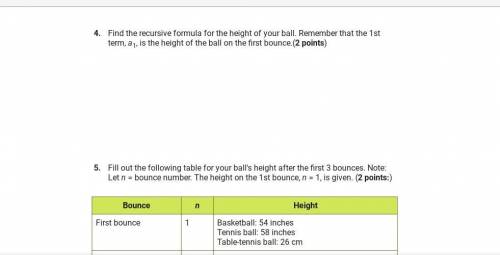
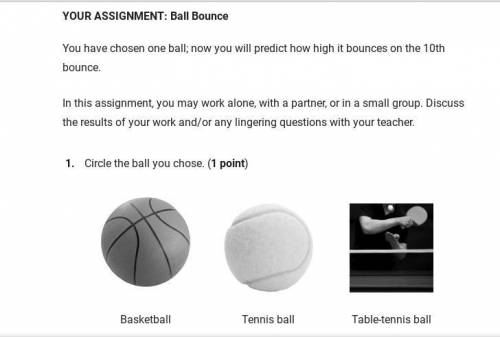
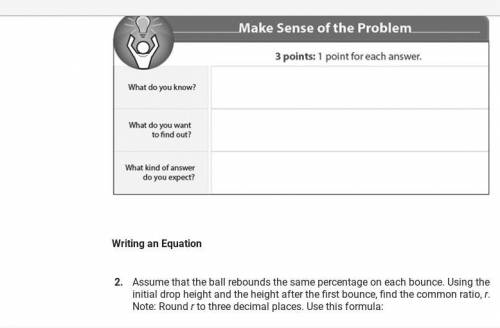

Answers: 1


Another question on Mathematics

Mathematics, 21.06.2019 15:00
Which of the binomials below is a factor of this trinominal? x^2-13+30
Answers: 2

Mathematics, 22.06.2019 01:10
Jobs and productivity! how do retail stores rate? one way to answer this question is to examine annual profits per employee. the following data give annual profits per employee (in units of 1 thousand dollars per employee) for companies in retail sales. assume σ ≈ 4.0 thousand dollars. 3.7 6.7 3.6 8.5 7.5 5.9 8.7 6.4 2.6 2.9 8.1 −1.9 11.9 8.2 6.4 4.7 5.5 4.8 3.0 4.3 −6.0 1.5 2.9 4.8 −1.7 9.4 5.5 5.8 4.7 6.2 15.0 4.1 3.7 5.1 4.2 (a) use a calculator or appropriate computer software to find x for the preceding data. (round your answer to two decimal places.) thousand dollars per employee (b) let us say that the preceding data are representative of the entire sector of retail sales companies. find an 80% confidence interval for μ, the average annual profit per employee for retail sales. (round your answers to two decimal places.) lower limit -- thousand dollars upper limit -- thousand dollars (c) let us say that you are the manager of a retail store with a large number of employees. suppose the annual profits are less than 3 thousand dollars per employee. do you think this might be low compared with other retail stores? explain by referring to the confidence interval you computed in part (b). yes. this confidence interval suggests that the profits per employee are less than those of other retail stores. no. this confidence interval suggests that the profits per employee do not differ from those of other retail stores. correct: your answer is correct. (d) suppose the annual profits are more than 6.5 thousand dollars per employee. as store manager, would you feel somewhat better? explain by referring to the confidence interval you computed in part (b). yes. this confidence interval suggests that the profits per employee are greater than those of other retail stores. no. this confidence interval suggests that the profits per employee do not differ from those of other retail stores. (e) find an 95% confidence interval for μ, the average annual profit per employee for retail sales. (round your answers to two decimal places.) lower limit 3.75 incorrect: your answer is incorrect. thousand dollars upper limit 6.41 incorrect: your answer is incorrect. thousand dollars
Answers: 3

Mathematics, 22.06.2019 01:50
If its non of them tell me..valerie took a day-trip. she drove from her house for a while and took a coffee break. after her coffee break, she continued driving. after 2 hours of driving after her coffee break, her distance from her house was 210 miles. her average speed during the whole trip was 60 miles per hour.valerie created the equation y−210=60(x−2) to represent this situation, where xx represents the time in hours from her coffee break and yy represents the distance in miles from her house.which graph correctly represents valerie's distance from her house after her coffee break?
Answers: 1

Mathematics, 22.06.2019 02:00
Are you guys willing to me with these last 8 questions on my homework for math reply to this question that i posted
Answers: 1
You know the right answer?
Questions

















Social Studies, 07.08.2019 04:20

Social Studies, 07.08.2019 04:20

Social Studies, 07.08.2019 04:20

Mathematics, 07.08.2019 04:20



